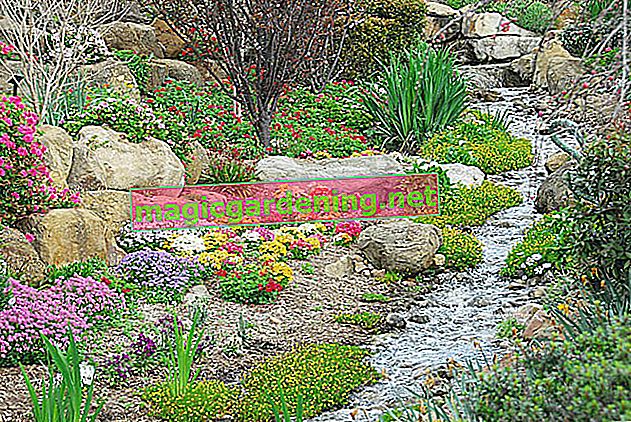
the essentials in brief
- Conventional root barriers are made of plastic and have to withstand the soil climate. Metal alternatives are uncommon.
- The material is laid vertically on the walls of the planting hole. Foils between 20 and 80 centimeters wide are sufficient for most plants.
- Hardware stores offer products from their own brands and high-quality manufacturers at prices between seven and 14 euros per meter. Cheap alternatives are dimpled sheets or recycled material scraps and old containers.
- Numerous ornamental grasses as well as berry bushes and ornamental trees require root barriers. Some herbs and climbing plants also develop root runners.
Tips on buying
Flexible root barriers are offered in roll form and usually have a material thickness of two millimeters so that they can withstand the pressure of the roots. You can determine the dimensions yourself and cut the foils to size. Plastic is a common material for a root barrier. There are alternatives made of metal for certain areas of application.
also read
- Prevent the raspberries from spreading with a root barrier
- Growing ground elder? Better only with a root barrier!
- When is a root barrier necessary for the tree?
Properties of an ideal root barrier:
- resistant to chemicals and solvents
- acid, salt and alkali resistant
- resistant to mold and microorganisms
- to protect cables with a waterproof coating
- free of plasticizers and toxins that could get into the ground
plastic

The material offers the great advantage of flexibility. According to a study by the Weihenstephan University of Applied Sciences, a 70 centimeter wide film provides the best protection against root pressure of most ornamental plants in the garden. Root barriers made of polyethylene or polypropylene are common. The ends of the film are connected with aluminum rails that can be screwed together. Root extensions cannot grow through these rails. Many manufacturers grant a 25-year guarantee on material resistance for their products.
| Polyethylene | Polypropylene | |
|---|---|---|
| abbreviation | HDPE | PP |
| properties | particularly high density and resistance | easy handling due to low weight |
| Note | Laying requires more effort | not suitable for bamboo |
Metal root barrier
Since most metals have no protection against corrosion, they are not suitable for permanent use in the earth. An alternative with an unfavorable price-performance ratio would be stainless steel. However, there are metal root barriers that are offered specifically for lawns. This will prevent the lawn from spreading on paving stones or growing into the flower beds. Galvanized metal rails made of aluminum, stainless steel or steel are used, which are inserted vertically into the earth.
Application of the root barrier
YoutubeDig out the planting hole and line the walls completely. Make sure that the foil is vertical. Slight slopes lead to the roots being directed upwards. Cut the foil so that the ends overlap four to eight inches. The plants are then inserted and the hole filled with topsoil. The overlaps must not be pulled apart. You can also close the foils with butyl tape or aluminum rails.
How deep is the root barrier laid?
The depth depends on the type of plant. Usually, a 70 centimeter wide film is sufficient to suppress the formation of runners in most plants. Many vigorous herbs and shallow-rooted berry bushes conquer depths of between 20 and 50 centimeters with their roots. Imposing ornamental grasses are restricted, depending on the species, with a root barrier that extends 60 to 80 centimeters into the ground.

Alternatives to root barriers
In numerous hardware stores you will find a wide selection of high-quality branded products and inexpensive alternatives to private labels. For smaller plants, old pots or scraps of material are usually sufficient from which you can make root barriers yourself.
| width | material | Price per square meter | providers | |
|---|---|---|---|---|
| Gardol root barrier | 70 cm | PP | 11.40 euros | bauhaus |
| FloraSelf root barrier | 65 cm | Synthetic fiber with one-sided HDPE coating | 8.79 euros | Hornbach |
| Root barrier Premium | 70 cm | High-tech material | 13.33 euros | Obi |
| Dehner root barrier | 70 cm | PP | 12.85 euros | Stretcher |
| B1 root lock | 60 cm | Hard plastic | 7.14 euros | Toom |
Recycle containers and scraps of material
If it is a question of small perennials with a high tendency to spread, you can put the root ball in a disused mortar bucket and sink it into the ground. You should not use containers made of untreated metal, as they rust from moisture in the earth.
Many ornamental grasses or sea buckthorn can be planted with conventional roofing membrane. The roots of the vigorous raspberries can be dammed with fleece, which is laid to a depth of 40 centimeters. You should make sure that the ends of the material are connected to one another.
Roofing foil, garden fleece or tubs can be used as a root barrier for some plants.
Dimple membrane as a root barrier?
The insulation layer for basement rooms is suitable as a root barrier if the material offers the same properties as conventional barrier film and the dimensions are correct. The most common Gutta dimpled sheet 'Star' has a material thickness of eight millimeters and is between 50 and 100 centimeters wide. It consists of durable HDPE and is cheaper than a root barrier at an average price of 1.80 euros per running meter.
Which plants restrict with root barriers?
Each plant has different propagation strategies and competitive strengths. Weak species invest their energy in developing flowers and seeds so they are not a problem. Strong herbs, grasses and shrubs conquer large areas in a short time by developing underground runners.
Tips
If you plant herbs such as mint or ground elder in the garden, you should also think of a root barrier here. A large plastic pot sunk in the ground is sufficient.
Grasses

Sweet grasses include annual as well as perennial and perennial species, many of which are planted as ornamental grasses in the garden. Their growth can be broadly divided into two categories. Grasses that form dense or loose clumps are usually true to their location and do not grow uncontrollably in the bed. The grass-like growth form results from runners that crawl on the surface of the earth or are formed underground by the roots. Such species need a rhizome barrier:
- Chinese reed Eulalia (Miscanthus sinensis 'Gracillimus') forms roots at depths between 30 and 40 centimeters
- Chinese reed (Miscanthus sinensis) develops roots around 50 centimeters deep
- Zebra grass roots (Miscanthus sinensis 'Zebrinus') reach 50 to 70 centimeters into the ground
- Japanese blood grass (Imperata cylindrica) has roots 60 to 100 centimeters deep
- Giant Chinese reed (Miscanthus × giganteus) grows up to 100 centimeters deep
- Reed (Phragmites australis) can develop roots up to two meters deep
background
This is how bamboo grows
Bamboo is a subfamily of grasses, the species of which form two different rhizome bodies. The first growth form is characterized by short and thick rhizomes. They develop more or less compact clumps that grow separately from one another.Long and thin rhizome bodies are characteristic of the second growth form. Such bamboo species grow more openly, so that the stalks are evenly distributed over a wide area. They are considered to be able to spread, which is why a root barrier for such bamboo species at a depth of 60 centimeters is useful.
trees and shrubs
A tree develops strong roots over the course of its life, which can damage buildings or paving stones. How deep the roots reach into the earth depends on the species. Deep roots reach a root depth of between two and four meters, while shallow roots develop their roots extensively in the uppermost soil layers. Many of these trees need a root barrier because they spread through underground runners.
Tips
The wisteria is a climbing plant that roots deep and shallow at the same time in search of water. Therefore, a root barrier for the wisteria at a depth of 70 centimeters makes sense.
Ornamental shrubs
For most shrubs, root barriers with a thickness of three to four millimeters and a height between 45 and 50 centimeters are sufficient. Hydrangea, ranunculus or magnolia prove to be particularly easy to spread and should be enclosed with a four to ten millimeter thick barrier film, depending on their root strength.
How deep root barriers must be:
- Thuja : 70 to 80 centimeters
- Willow : between 30 and 50 centimeters, depending on the species
- Rosa rugosa : 60 to 70 centimeters
The vinegar tree is a good example of shallow-rooted trees. On sandy and nutrient-poor soils, the species grows within a radius of ten meters around the trunk and forms strong thickets there. Root barriers with a thickness of ten to 15 millimeters are recommended.
Fruit bushes

Many fruit bushes are known for their ability to spread and take up large areas within a very short time. It is not uncommon for the trees to spread over a radius of more than two meters and suppress any vegetation in this area. This growth is typical for shrubs from the rose family:
- wild blackberries need root barriers at a depth of up to 30 centimeters
- similar dimensions for varieties like the blackberry 'Navaho'
- Root barriers for raspberries should be 40 centimeters deep
- Sloe is planted with a 50 centimeter deep root barrier
- Aronia root barrier should reach 60 centimeters into the ground
When are root barriers unnecessary?
In contrast to its related name, Buddleia does not have a root barrier, because the shallow-rooted shrub does not form any underground runners. Syringa vulgaris reproduces via root runners, which can be a nuisance in certain situations. Therefore, a root barrier for lilac is useful.
Plants that can do without a root barrier:
- Pampas grass (Cortaderia selloana) forms attractive clumps
- Chinese reed varieties of the 'condensatus' variety usually grow like clumps
- Sacred bamboo does not develop runners
frequently asked Questions
What is a root barrier?
A root barrier prevents a plant from spreading uncontrollably through subterranean runners in the garden. Resistant foils are commonly used to prevent the roots from growing into undesirable areas. The term rhizome barrier is used synonymously. Such root barriers are available from Bauhaus, Hornbach or similar hardware stores.
What is the difference between root lock and root guide?
Root barriers are smooth foils that lead to the so-called flower pot effect on trees. The flat growing roots spread counterclockwise and circularly on the smooth-walled barrier. Since the tree loses stability with increasing height, the root guide was developed. Such systems contain vertical ribs that lead the roots downwards. Once these have reached the lower edge of the barrier, they continue to grow in accordance with their natural direction of growth.
Is a root barrier necessary?
Whether you should integrate a root barrier into the soil depends on the particular plant. A barrier film is unnecessary for clumpy growing species, as these do not spread over underground runners. Flat growing ornamental grasses and herbs or berry bushes that spread freely should be equipped with a root barrier, provided that uncontrolled growth is not desired. For smaller plants, you can use alternatives such as roofing film, or you can put the plants in a permanent plant pot and sink it into the ground.
Does the fig tree need a root barrier?
The common fig is one of the heart roots, the root system of which is wider than the crown and develops a hemispherical shape. Usually it is not necessary to provide the tree with a root barrier. The root system needs space to develop splendidly. Since figs are preferably planted in sheltered locations in Germany or drawn as a trellis on the house wall, a root barrier is useful as foundation protection.
Can I plant bamboo without a root barrier?
Whether your bamboo needs a root barrier depends on the species. There are clumpy growing representatives that get by without a root barrier. Large-area ornamental grasses tend to spread uncontrollably and should be restricted with an underground barrier. If you plant bamboo, a root barrier with a width of 60 centimeters makes sense.
- a bamboo plant gets a root barrier with a diameter of 150 to 200 centimeters
- The top of the barrier should protrude about two inches from the ground
- Foil is laid so that the diameter at the bottom is smaller than the top
Can I retrofit a root barrier?
It is possible to integrate a root barrier in the garden afterwards, but not recommended. Overgrown plants such as bamboo develop a far-reaching root system and can also sprout again from separated pieces of rhizome. Dig a trench around the plant, the diameter of which is larger than that of the root ball. During this work you will come across the subterranean runners that you will have to cut with a spade and pull out of the earth.








